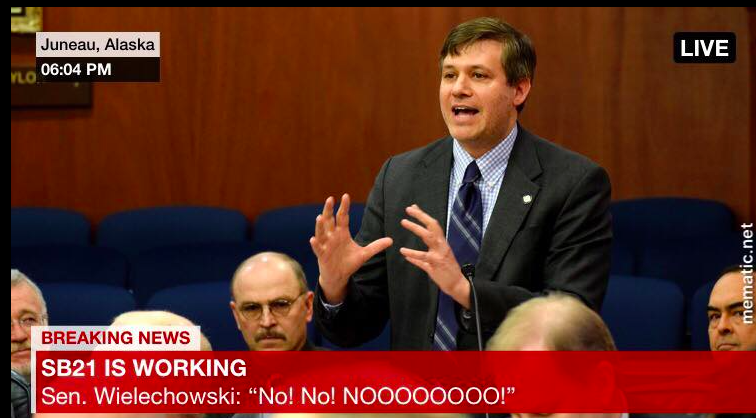Now for some good news. Andrew Jensen, editor of the Alaska Journal of Commerce, shared his thoughts on the success of SB 21, the oil tax reform that took the place of ACES in 2013, and was ratified by voters in a 2014 referendum.
‘GAME OVER FOR WILECHOWSKI’
If Sen. Bill Wielechowski is true to his word, we’ve heard the last from him about changing Alaska’s oil taxes.
Back on June 10, 2014, Wielechowski and now-former Sen. Hollis French (who Gov. Bill Walker appointed to the Alaska Oil and Gas Conservation Commission last year) issued a “very simple challenge.”
“If SB 21 produces new oil, even ONE additional barrel, and this production results in increased revenue to the state, even ONE more dollar we will drop our support for revising oil taxes,” Wielechowski said.
The legislation proposed by Wielechowski and French called for the previous system known as ACES to be retroactively implemented in 2019 “if there is not one new barrel of oil produced compared to the 2013 TransAlaska Pipeline moving average of 531,000 (approx.) and total oil revenues from 2014 to 2018 are not any greater under SB 21 than they would have been under ACES.”
Whoops.
On Oct. 25 in Juneau, state Revenue Department officials released a revised production forecast for the current fiscal year of 533,000 barrels per day.
That’s 1,999 barrels more than needed under Wielechowski’s and French’s challenge and by the time the fiscal year ends next June 30 it could be plenty more.
We’ve yet to reach the peak production months on the North Slope, yet in September the daily rate was 512,000 barrels per day compared to 474,000 per day in September 2016.
So far in October, the daily production is 537,000 barrels per day compared to 525,000 per day in the same month last year.
This puts the North Slope on track for its third straight year of production increases in the four full fiscal years that Senate Bill 21 has been in place despite the fact prices have cratered from about $112 per barrel when it passed to as low as $26 per barrel in January 2016.
Meeting the revenue half of the Wielechowski-French challenge is even more of a layup.
Nobody, not even the Democrats, disputes that SB 21 has collected more production tax revenue than ACES would have at the prices from 2014-18. ACES would have collected zero production taxes at prices less than $63 per barrel, which we haven’t seen since the first quarter of 2015. The revised price forecast doesn’t expect prices to cross the $63 threshold until 2020.
That represents hundreds of millions more in revenue under SB 21 versus ACES.
Game over.
Early indications are Wielechowski has either forgotten about the gauntlet he and his former Democrat colleague laid down or doesn’t intend to abide by it.
He was tweeting the day after about how we haven’t reached former Gov. Sean Parnell’s goal of 1 million barrels per day and then turned his attention to the difference in production tax revenue versus the entirely separate subject of oil tax credits.
[Read more at the Alaska Journal of Commerce]

What is our current tax credit liabiity? Someone told me it was now $2.8 billion. I questioned the figure but what is it currently?
Chris – There are so many credit programs from Cook Inlet to North Slope, and some are not active now but still must be paid. I don’t know the answer to how much is outstanding but I’ll try to come up with a legitimate number.
Oil and Natural Gas Liquids
Alaska – 485,787 bbls / day
N. Slope – 470,972 bbls / day
Cook Inlet – 14,815 bbls / day
August 2017 Production Excel File
SB 21 was not successful, because Alaskans loss half their Permanent Fund dividends. The oil corporations are not paying any taxes to Alaska.